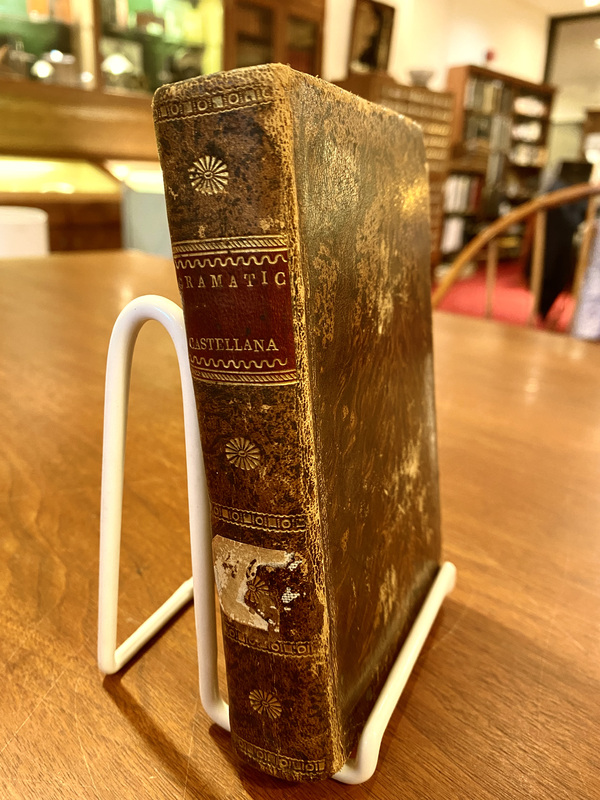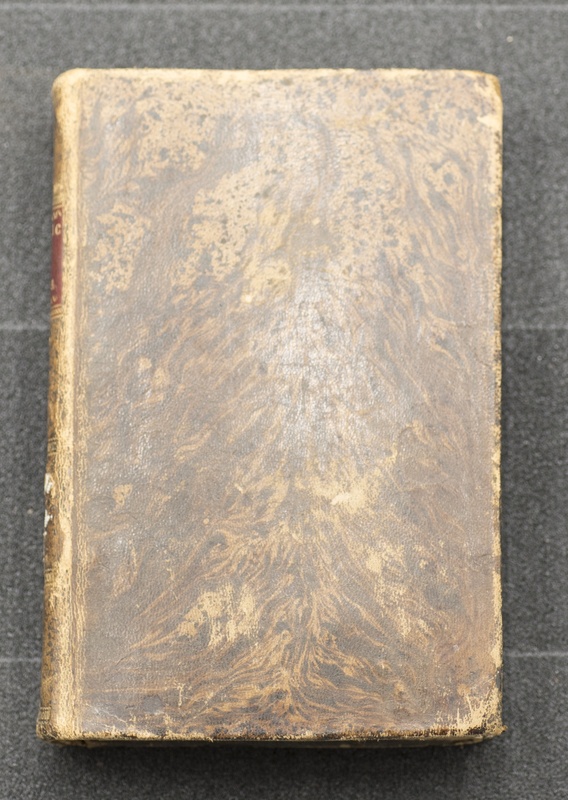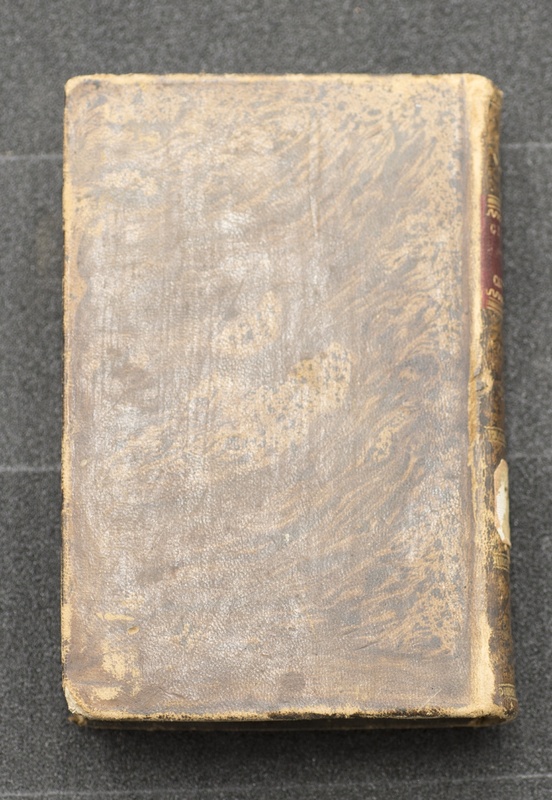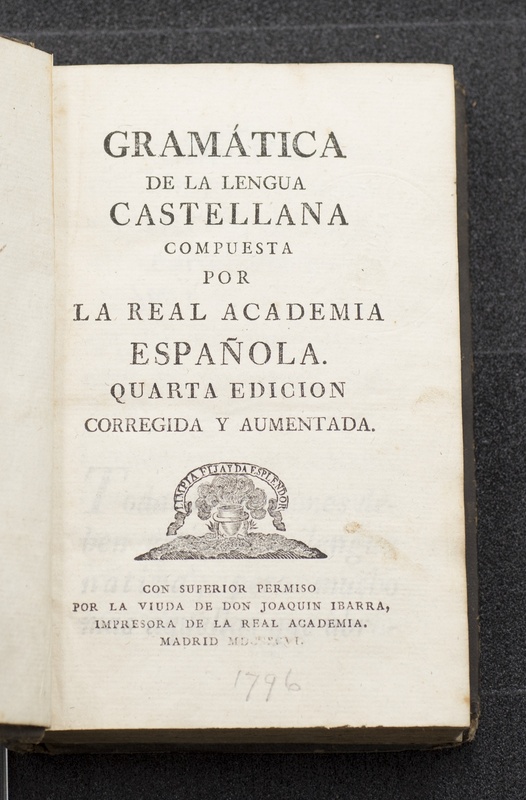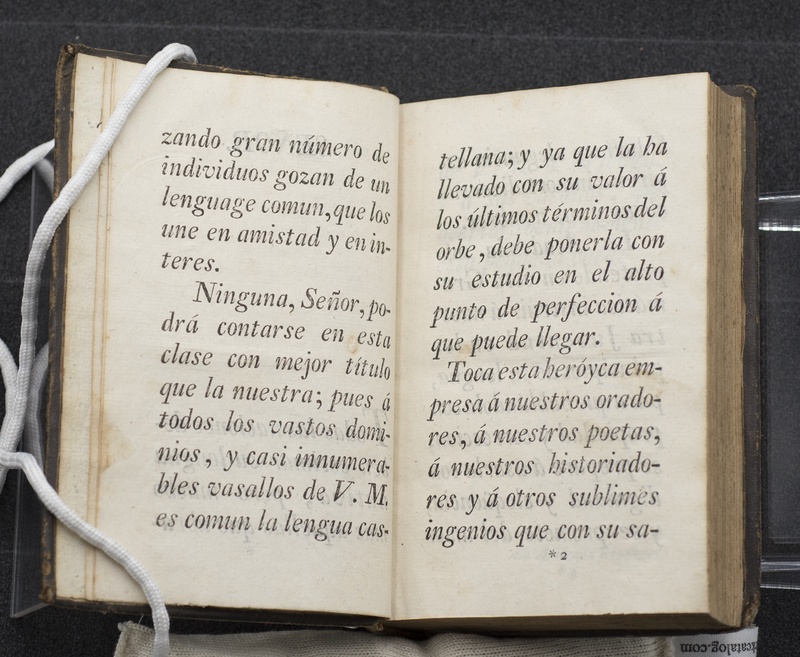La Gramática de la Lengua Castellana
Item
- Title
- Creator
- Date
- Description
- edition
- Publisher
- Type
- Extent
- Language
- Format
- Identifier
- Rights
- Subject
- Illustrative content information
- Secondary Features
- Genre/form
- Book format
- Publication Information
-
es
La Gramática de la Lengua Castellana
-
es
La Real Academia Española
-
1796
-
en
La Gramática de la Lengua Castellana not only offers a linguistic lens into how the Spanish language was changing at the end of the 18th century, but also suggests the cultural importance of having an official language for Spain’s political ambitions at the time. The book of grammar was published in 1796 in Madrid, and it is the fourth edition. It consists of a dedication, a prologue, and the main text of grammar. It was created by the Spanish Royal Academy for educational purposes, but also had the political purpose of uniting Spain under one language. The dedication is directed formally to the King, indicating its royal importance in uniting the Spanish empire. The beginning of the main text says, “Grammar is the art of speaking well.” This statement appears impartial but from a linguist’s perspective is restrictive to language and implies proper and improper ways to speak the language, leaving little room for diversity. An engraving on the title page of a crucible in flames, a symbol of purification, states the Spanish Royal Academy’s mission to “Clean, Fix, and Give Splendor,” which reiterates the purpose of strengthening conformity under the empire (see Title page). The history of the publication of the book of grammar as a royal charge dates back to 1492, when Antonio de Nebrija (1441-1522) wrote the first edition. He presented it to the Catholic Queen Isabela and told her that “language was always a companion of the empire.” So, since the beginning of the colonization of the Americas, the Castilian language has functioned as a unifying tool of the Spanish Empire. Although the body of the text does not stray from grammatical rules, there are aspects of the book that certainly suggest the imperial importance of the text in the 18th century.
-
es
La Gramática de la Lengua Castellana no solo ofrece una lente lingüística sobre cómo cambiaba el idioma español a fines del siglo XVIII, sino que también sugiere la importancia cultural de tener un idioma oficial para las ambiciones políticas de España en ese momento. El libro de gramática fue publicado en 1796 en Madrid, y es la cuarta edición. Consiste en una dedicación, un prólogo, y el texto principal de gramática. Fue creado por la Real Academia Española con fines educativos, pero también tenía el propósito político de unir España bajo un idioma. La dedicación se dirige formalmente a las Altezas Reales, indicando su importancia real para unir el imperio español. El principio del texto principal dice "La gramática es el arte de hablar bien" (1). Esta frase parece imparcial, pero desde la perspectiva lingüística es restrictiva del idioma e implica maneras adecuadas e inadecuadas de hablar, algo que deja poco espacio para la diversidad. Un grabado en la portada de un crisol en llamas, símbolo de la purificación, afirma la misión de la Real Academia Española de “Limpia, Fija, y Da Esplendor,” lo que reitera el propósito de fortalecer la conformidad bajo el imperio (véase Title page). La historia de la publicación de la gramática como un cargo real se remonta a 1492, cuando Antonio de Nebrija (1441-1522) escribió la primera edición. La presentó a la Reina Católica Isabela y le dijo que “siempre la lengua fue compañera del imperio.” Así, desde el principio de la colonización de las Américas, la lengua castellana ha funcionado como una herramienta unificadora del Imperio Español. Aunque el cuerpo del texto no se extravía de las reglas gramáticas y mantiene un registro científico, hay aspectos del libro que ciertamente sugieren la importancia imperial del texto el siglo XVIII.
-
en
Fourth edition
-
es
Cuarta edición
-
es
La Real Academia Española
-
en
Book
-
es
Libro
-
en
511 pages
-
es
511 páginas
-
en
Spanish
-
es
Español
-
4.0” X 6.0”
-
Rare PC 4111.A3
1796
-
en
This material is made available for use in research, teaching, and private study, pursuant to U.S. Copyright law. The user assumes full responsibility for any use of the materials, including but not limited to, infringement of copyright and publication rights of reproduced materials. Any materials used should be fully credited with the source. Permission for publication of this material, in part or in full, must be secured with the Head of Special Collections.
-
es
Este material se ha hecho disponible para uso en investigaciónes, tanto académicas como privadas, y en la docencia, de conformidad con la ley de derechos de autor de EE. UU. El usuario asume toda la responsabilidad por cualquier uso de los materiales, incluida, entre otras, la infracción de los derechos de autor y los derechos de publicación de los materiales reproducidos. La fuente de cualquier material utilizado debe acreditarse claramente. El permiso para la publicación de este material, en parte o en su totalidad, debe obtenerse de el/la/le Jefe de las Colecciones Especiales de WLU.
-
en
Grammar manuals
Linguistic norms
Royal Spanish Academy
18th century
-
es
Manuales de gramática
Normas lingüísticas
Real Academia Española
Siglo XVIII
-
en
Insignia of the Real Academia Española (title page); image of flaming crucible with motto
Decorative ornaments: floral motif (pg. 1; 273)
-
es
Insignia de la Real Academia Española (portada); imágen de un crisol en llamas con lema
Ornamentos decorativos; motivo floral (pg. 1; 273)
-
en
Armorial book plate with the signature of James Campbell and his family crest
W&L Library book plate
2 signatures from previous owners: Wm from Mother, dated September 14, 1854; E. A. Ludwig, in pencil
-
es
Ex libris de James Campell con su firma y escudo de armas
Placa del adquisición de la biblioteca de W&L
2 firmas de propietarios anteriores: Wm de Madre, fechado el 14 de septiembre de 1854; E. A. Ludwig, a lápiz
-
en
Book of grammar
-
es
Manual de gramática
-
en
Hardback
-
es
Tapa dura
-
en
Place of Publication: Madrid
See title page: “With superior permission from the widow of Don Joaquin Ibarra, Printer of the Royal Academy.”
-
es
Lugar de publicación: Madrid
Véase a la portada: “Con permiso superior por la viuda de don Joaquin Ibarra, Impresora de la Real Academia.”
